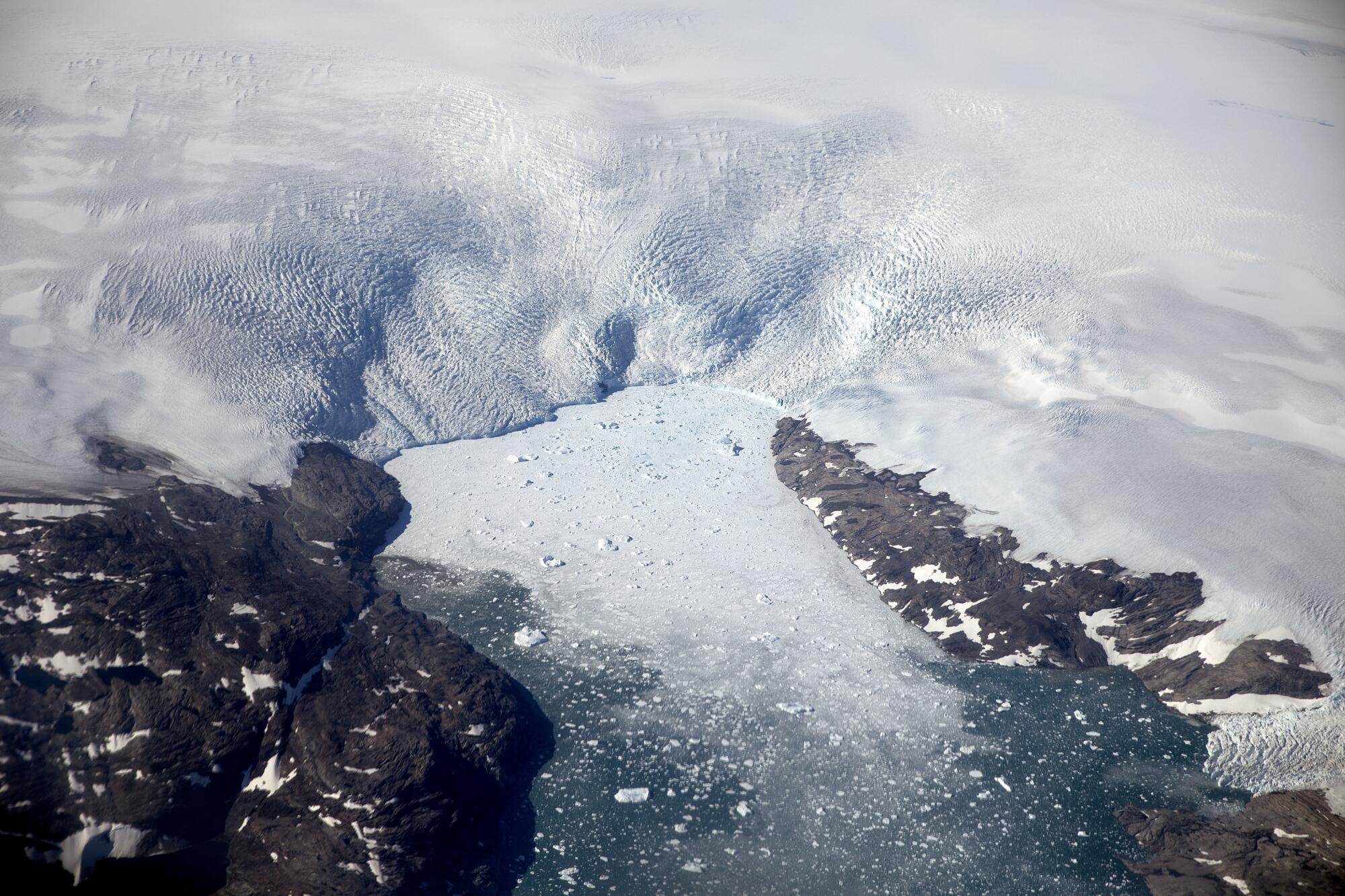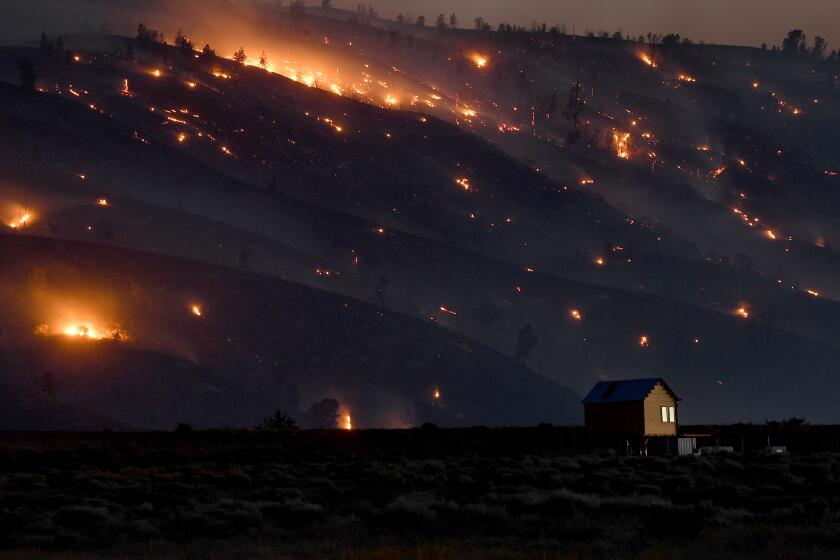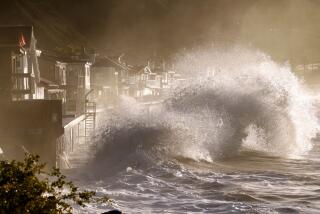
- Share via
Scientists are sounding the alarm that a crucial component of the planet’s climate system is in gradual decline and could one day reach a tipping point that would radically alter global weather patterns.
The Atlantic Meridional Overturning Circulation, or AMOC, is a system of ocean currents that circulate water in the Atlantic Ocean like a conveyor belt, helping to redistribute heat and regulate global and regional climates. New research, however, warns that the AMOC is weakening under a warming climate, and could potentially suffer a dangerous and abrupt collapse with worldwide consequences.
“This is bad news for the climate system and humanity,” researchers from Utrecht University’s Institute for Marine and Atmospheric Research wrote in a new study published in the journal Science Advances.

Considering the AMOC is the workhorse of the Atlantic, the consequences of such a collapse would result in “hugely chaotic changes in global weather patterns” that extend far beyond the Atlantic, said Daniel Swain, a climate scientist with UCLA who was not involved in the study.
“It would plunge Europe into essentially a regionalized Ice Age, while leaving the rest of the world on its continued warming path,” Swain said. “The Southern Hemisphere would roast, the Pacific storm track would go kind of nuts, and there would be these extreme shifts in weather patterns that are very different from what you would expect from a more incremental or linear warming path.”
Aggressive and impactful reporting on climate change, the environment, health and science.
The odds of such a collapse are low — about 5% or 10% this century, according to some researchers — but the consequences are so great that it would be unwise to ignore the possibility, Swain said.
“There’s still a [90%] to 95% chance that won’t happen, but would you be willing to bet the farm on a [90%] to 95% chance that something like this doesn’t happen?” he said. “Would you get on a plane if there were a [90%] to 95% chance that it won’t crash? I certainly wouldn’t.”
There’s a 55% chance La Niña could develop between June and August, and a 77% chance it could develop between September and November, NOAA said.
The AMOC moves water in the Atlantic Ocean from north to south and back again in a long cycle, but there are indications that it has been weakening over the last century, including a roughly 15% decrease since 1950.
The system relies on a delicate balance of warm surface water and cold, salty water that sinks toward the seafloor, which together keep the current churning. But as the planet warms, melting glaciers and ice sheets — such as the Greenland ice sheet — are adding more freshwater to the system, which is diluting its salinity and disrupting traditional patterns.
“It’s a self-amplifying feedback loop mainly affecting salinity, and the fresher the North Atlantic Ocean becomes, the weaker the AMOC, until you reach a critical value,” said René van Westen, the study’s lead author.

Subscribers get exclusive access to this story
We’re offering L.A. Times subscribers special access to our best journalism. Thank you for your support.
Explore more Subscriber Exclusive content.
The study does not place a time frame on when such a collapse could occur, and Van Westen said such estimates can be controversial. But the paper was the first to demonstrate that the AMOC can reach a tipping point if enough freshwater is added to the system.
“It is still heavily debated whether this is a possibility within the 21st century, but we cannot rule it out at the moment,” he said.
A similar scenario played out in the film “The Day After Tomorrow,” although experts said the events of that movie, which occur over the course of a few days, are heavily dramatized.
The Netherlands’ researchers say that models indicate an AMOC collapse is possible, and that such an event would significantly alter the planet’s climate. Its effects would be most acute in Europe, where temperatures could decrease up to 18 degrees Fahrenheit on average, or even as much as 36 degrees in places such as Norway and Scandinavia. It could also trigger “seesawing” conditions between the Northern and Southern hemispheres.
Other potential effects include rapidly rising sea levels, with more than 2 feet of sea-level rise possible along some coastal regions, including the Netherlands and the U.S. East Coast. New York City could be inundated by as much as 31 inches of sea-level rise, Van Westen said.
The Amazon rainforest would see its dry and wet seasons flipped, potentially leading to its own tipping point. (A separate study published this month found that parts of that rainforest could collapse as soon as 2050.)
Effects on the Pacific Ocean and U.S. West Coast would probably be smaller due to their distance from the Atlantic, Van Westen said. However, his models show that an AMOC collapse could result in reduced precipitation and slight cooling in Los Angeles, which would compete with the larger climate change signal toward regional warming.
In fact, the effect of the potential future collapse of the AMOC is in some ways a scenario distinct from the climate change effects that are already occurring, said Swain, of UCLA. Currently, climate change is primarily amplifying familiar preexisting patterns and risks, such as worsening wildfires in California, or more extreme downpours and floods.
“But a collapse of the global overturning circulation really would be different, because it would result in rearrangements of the jet stream, of the storm track, of which places on Earth are really cold relative to other places,” he said.
When wildfire smoke and extreme heat combine, they create a “synergistic effect” or an additional burden on people’s health, researchers say.
The jet stream — the river of air that moves storms eastward across the globe — often helps steer atmospheric rivers into California.
Such disruptions wouldn’t just affect climate and temperature conditions, they would also tear at the fabric of civilization. Agriculture in Europe would probably come to halt, while coastal cities would see major issues from flooding. Building codes and infrastructure would potentially become obsolete as seasonality and precipitation patterns rapidly shift warm places into cool ones, and vice versa.
“It would mean that all of the climate adaptation that we’re working on now would not necessarily be the climate that we would be experiencing,” Swain said.
Other experts said some of the scenarios outlined in the study are on the extreme end of what’s plausible. The model required exceptional amounts of freshwater flow into the Atlantic in order to trigger the tipping point — a quantity equal to about seven Greenland ice sheets — according to Josh Willis, an oceanographer with NASA’s Jet Propulsion Laboratory in La Cañada Flintridge.
Sign up for This Evening's Big Stories
Catch up on the day with the 7 biggest L.A. Times stories in your inbox every weekday evening.
You may occasionally receive promotional content from the Los Angeles Times.
“It’s still possible that the overturning will shut down, and if it does, it’ll have big implications,” Willis said. “But it’s not a meter of sea level right away and 15 degrees Celsius of cooling right away. It’s not ‘The Day After Tomorrow.’”
Still, Willis said the system may be more sensitive than previously understood, and future models and simulations could add to the growing body of work. Other recent studies have also warned of a forthcoming AMOC collapse, and of a potential collapse of the Antarctic Ocean current.
“It’s an interesting study,” he said of the latest paper, “and the AMOC could still yet prove to be shut-down-able. But this study is not necessarily conclusive about that. There’s still a lot of questions open.”
Lynne Talley, a distinguished professor at Scripps Institution of Oceanography at UC San Diego, said similarly that there is a “natural variability” to the AMOC that can include strengthening and weakening on a roughly decadal timescale, and cautioned against conflating recent changes with a long-term trend.
Every bit of planetary warming will have impacts beyond those already occurring, including biodiversity loss, longer heat waves and extreme rainfall.
However, she said the research into its potential collapse is compelling and worthy of consideration.
“First of all, it is possible.... I wouldn’t shy away from saying that,” she said.
Salinity studies are particularly valuable, she added, because salinity helps govern the density of water in the AMOC. A similar mechanism may have made the AMOC crash at the end of the last glacial period around 14,000 years ago.
Back then, a lot of freshwater got swept onto the North Atlantic from the melting of the North American ice sheet, “and that clearly slowed it down and it sort of stopped,” Talley said.
“I find it completely plausible that it would crash at some point, and the control is salt,” she said. “But what year that happens? I don’t know.”
Such a collapse would probably be irreversible — at least over any sort of timescale relevant to a human life. But there are safeguards for preventing such a collapse from occurring: namely, reducing methane, carbon dioxide and other fossil fuel emissions that are warming the planet, melting ice and releasing more freshwater into the ocean.
“That is really the solution to everything,” Talley said. “I think we have to safeguard against a lot of things with climate change, and this is one of the big ones for the Northern Hemisphere.”











